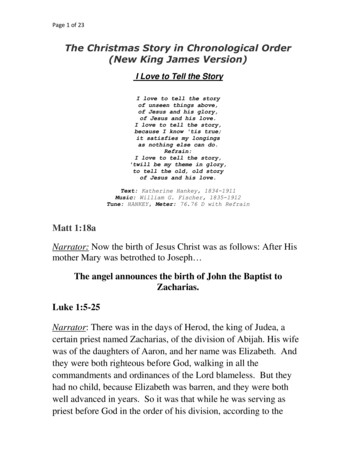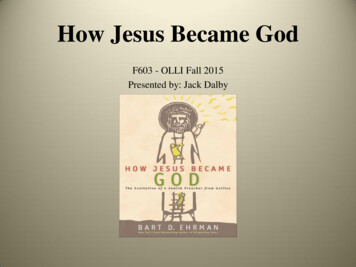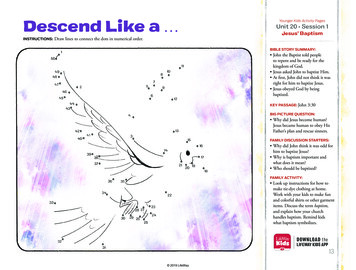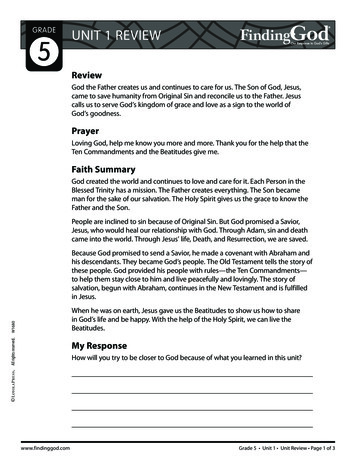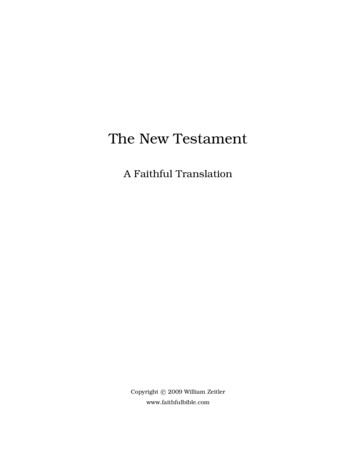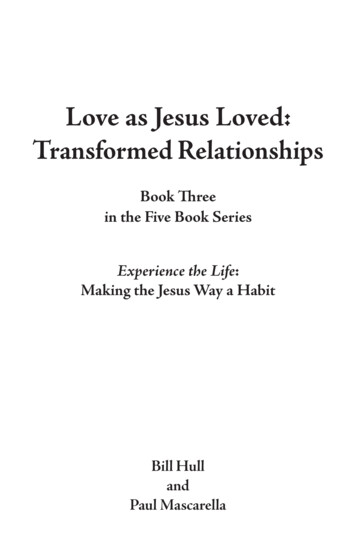
Transcription
Love as Jesus Loved:Transformed RelationshipsBook Threein the Five Book SeriesExperience the Life:Making the Jesus Way a HabitBill HullandPaul Mascarella
Trademark and Copyright InformationLove as Jesus Loved: Transformed RelationshipsCopyright 2007. Bill Hull. All rights reserved.No part of this publication may be reproduced, stored in a retrieval system, or transmittedin any form or by any means—without prior written permission of the publisher.Unless otherwise indicated, Scripture quotations used in this book are from the HolyBible, New International Version (niv). Copyright 1973, 1978, 1984 International BibleSociety. Used by permission of Zondervan Bible Publishers.Published by Biblical Studies Press1751 International Pkwy, Ste 101, Richardson, TX 75081www.bible.orgISBN: 0-7375-0134-0
CONTENTSIntroduction. 1About this Book. 2Week OneTransformed Relationships Are the SeedbedWhere Love Is Planted by the Power of Intention.12Week TwoTransformed Relationships Thrive in Communities Where LoveIs Grown in an Environment of Grace and in Relationships of Trust.32Week ThreeTransformed Relationships Remain Vital Only Where TruthIs Exercised within the Context of Love andIntegrity of Character Nurtures Trust.54Week FourTransformed Relationships Await Us along the Journey of Brokenness.77Week FiveTransformed Relationships Draw Their Strengthto Sustain a Life of Living for Others from the FertileSoil of Their Character Rich in Humility.98Week SixTransformed Relationships Marked by Acts of SubmissionAre the Evidence that One Fully Intends to Love as Jesus Loved. 123Appendix: Catching Up. 147
INTRODUCTIONTo experience the life is to commit to a way or pattern of life. Itsbasis is humility and it is a life of self-denial and submission to others.The life that Jesus lived and prescribed for us is different than the onebeing offered by many churches. His servant leadership was radicallydistinct from what is extolled by secular society and even too bold forwhat is modeled in the Christian community. This life is essentially thefaith of following, of taking up one’s cross daily and following him. It isfundamentally about giving up the right to run your own life. It is livingthe life that Jesus lived, the life to which he has called every disciple.To put it another way, we can only experience the life Jesus hascalled us to by committing to: Believe as Jesus believed Live as Jesus lived Love as Jesus loved Minister as Jesus ministered Lead as Jesus ledWill we choose to live as Jesus lived, to follow him regardless ofwhere he leads? Or, will we surrender to the powerful forces of our culture, incorporate its corrupting values, and adopt its devaluing methodsinto our pursuit of God? To do the latter is simply to begin by failing. Afaith which can accommodate both the world’s values and its methodsis not the faith to which Jesus calls us. It is not the faith which is the“victory that has overcome the world” (1 John 5:4). It is a faith which isbeing overcome by the world. It is only by experiencing the life that Jesuslived that we will “find rest for our souls” (1 John 5:4).
Love as Jesus Loved: Transformed RelationshipsAbout this BookIts PurposeExperience the Life exists to assist the motivated disciple in entering into a more profound way of thinking and living. That way is thepattern of life Jesus modeled and then called every interested person tofollow. Simply put, it is the living out of Jesus’ life by: believing as Jesusbelieved, living as Jesus lived, loving as Jesus loved, ministering as Jesusministered, and leading as Jesus led. This Life is a life grounded in humility—characterized by submission, obedience, suffering, and the joys ofexaltation. It is the life that transforms its adherents and penetrates thestrongest resistance. It then calls upon each person to rethink what itmeans to be follower of Jesus.This book is the third in the five-book Experience the Life series. It is designed to lead disciples in a 30-week course, built upon the ideasintroduced and developed in Bill Hull’s book, Choose the Life. It providesa daily format which directs a disciple’s thinking toward the applicationof these truths, thereby producing in him a faith hospitable to healthyspiritual transformation—a faith that embraces discipleship.Its ParticipantsVirtually all significant change can, should be, and eventually istested in relationship to others. To say that one is more loving without itbeing verified in relation to others is hollow. Not only do others need tobe involved to test one’s progress, they are needed to encourage and helpsomeone else in the journey of transformation. Therefore, going on thejourney with others is absolutely necessary.The five books are designed to lead each disciple in a personal journey of spiritual formation by his participation within a community ofdisciples, who have likewise decided to experience the life. If you are joining an Experience the Life community that has already completed the first twobooks in the ETL course (Book One: Believe as Jesus Believed, Week One) follow the instructions found in the Appendix.
Introduction The community is composed of (optimally) from two to eight disciples being led in this 30-week course to experience the life.Participants in the community agree to make time and performthe daily assignments as directed in each book. They have agreed to praydaily for the other members of their community and to keep whatever isshared at their community meeting in confidence. They will attend andfully participate in each weekly community meeting.Its ProcessWe recognize that all change, all spiritual transformation, is theresult of a process. Events may instigate change in people; they may provide the motive, the occasion, and the venue for change to begin, but thechanges that result in healthy spiritual transformation are the productof a process.We can glean a description of the transformational process fromthe Apostle Paul’s command in Romans 12:2,Do not conform any longer to the pattern of this world,but be transformed by the renewing of your mind. Thenyou will be able to test and approve what God’s willis—his good, pleasing and perfect will.This process of transformation asserts that the believer must nolonger conform to what is false, the “pattern of this world” (its ideas andvalues, and the behaviors which express them). Also, he must be transformed, which means his pattern must be changed, conformed to another pattern, (the truth), which is not “of this world.” This is done bythe process of “the renewing of your mind.” What does it mean to renewsomething? To what is Paul referring when he says that the mind mustundergo this renewal?To renew something means to act upon something in ways thatwill cause it to be as it was when it was new. The principle idea is oneof restoring something that is currently malfunctioning and breakingdown to its fully functioning state, its original pristine state, the stateit was in prior to it sustaining any damage. We must avoid the modernnotion that renewing something means simply replacing the old thing
Love as Jesus Loved: Transformed Relationshipswith an entirely new thing. Paul, and the people to whom he wrote thesewords, would simply not understand renew to mean anything like whatwe moderns mean when we use the word replace. They would understand that renewing the wheels on one’s cart meant repairing them totheir fully functioning state. And so, what Paul means by “being transformed by the renewing of your mind” (emphasis ours) is that the mindmust undergo changes, repairs that will restore it to its original condition, the fully functioning state it enjoyed when it was first created. Asthese repairs proceed in the restoration/renewal process and a detrimental modification to the original design is discovered, that modificationmust be removed. It must be removed so that it will not interfere withits operating as it was originally designed. Further, to properly renewanything, we must understand its original design. The best way to renewsomething is with the direction and assistance of the original builder. Abuilder in Paul’s day was not only the builder but also the designer andarchitect. With the expertise and help available through the builder, fullrenewal is best accomplished.If you are renewing a house, that house’s builder would best knowhow to go about it. If you are renewing an automobile, that automobile’sbuilder would best know how to go about it. In our case, we are renewingthe mind. It stands to reason then, that its renewal would best be accomplished in partnership with its Architect/Builder—God.We know that it is the mind that is to be renewed, and that weshould partner with God to accomplish its renewal, but what is it aboutthe mind that is being renewed? Is it broken, in need of new parts?When Paul says that it is the mind which is being renewed whenspiritual transformation is taking place, he means much more than whatmost of us think of when we use the word mind. Most of us think of themind as some sort of calculator in our head, so, it’s understandable thatour idea of renewing it would start with the idea of replacing its brokenparts. But for Paul, the mind is much more than a calculator in our head,and that to renew it means more than simply swapping out a sticky key,or a cracked screen, or replacing the batteries that have run low.
Introduction The Greek word that Paul uses and is translated as the Englishword mind is νους. Here it means the inner direction of one’s thoughtsand will and the orientation of one’s moral consciousness. When Paulrefers to our mind’s renewal, he is saying that the current direction ourthoughts and will must be changed. The way our mind currently directsour thoughts and will no longer leads to where the mind was originallydesigned to take our thoughts and will. Our mind no longer leads ourthinking to know the will of God, to know what is good, pleasing, andperfect, and no longer directs our will to accomplish God’s will, to dowhat is good, pleasing, and perfect. This is in large part what is meantby being lost. If our minds are not renewed, then we cannot live a lifedirected toward doing what is pleasing to God. We need to undergothe restoration process that will return our minds to operating as theywere originally designed, allowing our minds to direct our thinking andwill toward God. The good news is that the original Builder/Architect—God—prescribed the renewing of the mind as the sure remedy torestoring us to spiritual health, and He intends to partner with us in thisrestoration process.For spiritual transformation to occur there must be a partnershipbetween the Holy Spirit and the person who is to undergo transformation. It is good news that the Holy Spirit is involved in the process of ourrestoration because, unlike other things that undergo restoration, likehouses, tables, and chairs, we are not just passive things. We are more.We are beings, human beings, made in the image of God. Being made inthe image of God includes much more than I will (or even can) mention,but for our purposes it includes having thoughts, ideas, passions, desires,and a will of our own. Because these abilities in their current condition(i.e. before renewal) no longer lead us toward God’s will, we do not havethe ability to direct our own transformation. We need someone who isnot “conformed to the pattern of this world,” one who is completely conformed to the will of God, to direct the renewal. And because we are inthis pre-renewal condition, we need someone to initiate, to enable us,and encourage us to continue the process, someone who is not subjectto the same problems our condition allows. Who is better to direct thanGod? Who is better to enable and encourage than God? There is none
Love as Jesus Loved: Transformed Relationshipsbetter suited to the task than the Holy Spirit. That we are partneringwith him is good news indeed!With the initiating, enabling, and direction of the Holy Spirit, theprocess of renewal can begin. It is a two-stage process: the appropriationof the truth and the application of truth-directed behavior. The first stage,the appropriation of the truth takes place when:1. we have the desire to pursue the Truth to be changed;2. we then act upon that desire, choosing to pursue the Truth bysetting our will.The second stage, the application of truth-directed behavior takesplace when:1. we begin practicing behaviors, which we’ll describe as spiritualdisciples, designed to halt our conformity to “the pattern of thisworld;”2. we engage in transformational activities, which are designed toreorient our mind and direct it toward God’s will;3. we continue to practice transformational activities to introduceand establish new patterns of thinking and behavior which conforms our mind to the mind of Christ.The same components in the process for renewing the mind thatwe gleaned from the Apostle Paul can also be seen in Jesus’ call to anyonewho would follow him.Jesus commanded to all who would follow him (i.e. all disciples)to:Come to me, all you who are weary and burdened, and Iwill give you rest. Take my yoke upon you and learn fromme, for I am gentle and humble in heart, and you willfind rest for your souls (Matthew 11:28-29).Jesus begins with a promise, “Come and I will give you rest.” Hekindles a desire to follow him. This is the first step in the appropriation oftruth, the desire to pursue the Truth. We desire change. Next Jesus’ command to take His yoke. This is the second step in the appropriation of
Introduction truth, choosing to pursue the truth. We set our will to change. At this step,we can choose to pursue our desire for the truth and change or ignoreit. If we choose to delay placing it upon our shoulders it is at the cost ofrest to our souls. The choice precedes the action. Next, we read that weare to take His yoke.To take His yoke is the first step of the second stage in the processof renewing the mind, the application of truth-directed behavior. At thisstep, as we saw before with Paul, we discontinue with our currentways, which conform us to the pattern of this world. We intentionallybegin to dislodge the destructive patterns which have grown in us as aprecursor to the second step, the taking-upon of a new way, God’s way,His yoke.The second step, the taking-upon of Jesus’ yoke, is the part of theprocess of renewing the mind where the vacancy left from dislodgingour old ways, “the pattern of this world,” is being filled up with the newlife-giving patterns by which we are to conform our lives. It is this yoke,God’s new way of living the life that Jesus lived, that is to be taken uponus. Just as the yoke for an oxen is placed upon its body, allowing thepower of the oxen to perform its master’s work (work the oxen wouldotherwise not be able to accomplish), so also Jesus’ yoke must be placedupon our body to allow it to perform our Master’s work, the renewing ofour mind (work we would otherwise not be able to accomplish).Finally, we see the third, and last step, in the application of truthdirected behavior. This is the final step in the process of renewal, but it isalso the beginning step in the ongoing process of our spiritual transformation. It finally brings us all the way to our taking Jesus’ yoke upon us.It also begins the continuing journey of knowing and doing God’s good,pleasing, and perfect will. While the second step trains the mind throughestablishing patterns, the third step lives out the new character that hasreplaced the old. This continuing journey begins once we take His yokeupon us. For then we begin to “learn from me [ Jesus]” and thereby experience rest for our soul. This rest, this peacefulness that comes fromlearning from Jesus, is what it is to live with a renewed mind. It is experiencing the Spirit initiated, encouraged, enabled, and empowered life
Love as Jesus Loved: Transformed RelationshipsJesus enjoyed with the peace that comes only by having the “mind ofChrist” and by accomplishing his good, pleasing, and perfect will.Experience the Life provides the disciple a structured process whereby he can engage in the process of spiritual renewal. It provides a dailyregimen for practicing specific disciplines designed to displace those olddestructive ideas and behaviors (i.e. “the patterns of the world) and replacing them with new, constructive, life-giving ideas and behaviors (i.e.the mind of Christ).Experience the Life requires commitment to consistently practicethe disciplines and to reserve the time required for transformation.Most studies on change agree that displacing a current habit or ideaand establishing a new one requires a minimum of about three months.Also, learning studies demonstrate the necessity of consistent application of the thing being learned to ensure its permanent retention.According to a leading learning researcher, people remember: 10% of what they read 20% of what they hear 30% of what they see 50% of what they see and hear 70% of what they say 95% of what they teach someone else Simply put, we learn best not by passively hearing and seeing, butby actively “doing” the thing which we are learning.The most relevant question a teacher can ask is, “Are my studentslearning?” For our purposes, the relevant question must be,“Am I engagedin a process that will result in my being changed from what I am intowhat I am to be? Am I being transformed into the image of Christ?” William Glassner, Control Therapy in the Classroom (New York: Harper and Row, 1986);Reality Therapy: A New Approach to Psychiatry (New York: Harper and Row, 1965).
Introduction Each book in this series provides a solid opportunity for significanttransformation through the use of several common tools or disciplinesincluding: Reading Scripture together Reading a common philosophy of the Christian experience Journaling insights, questions, and prayers Discussion over material that has already been studied, prayedover and reflected upon Accountability for the purpose of helping each other keep theircommitments to God Encouragement to help each other overcome areas of defeat andbreak free of bondage Mutual commitment to apply what God has impressed on eachmember Mutual commitment to impact those with whom they havecontactIts PatternThis course leads the believer to experience the life Jesus lived, utilizing a daily regimen to practice the various spiritual disciplines. Thecourse is thirty weeks long over five books.The five books, each six weeks in length, instruct and challenge thedisciple to conform their life to:1. Believe as Jesus believed,2. Live as Jesus lived,3. Love as Jesus loved,4. Minister as Jesus ministered, and5. Lead as Jesus led.Each six-week book leads disciples through a course of daily teachings and exercises in an examination of how Jesus lived out his faith.
10 Love as Jesus Loved: Transformed RelationshipsIn daily session, the disciple begins with a prayer focused on theissues to be presented in the daily reading. The daily reading gives a corethought that will be explored in the day’s exercises. Questions are designed to help the disciple’s understanding of the core thoughts and keyideas. Disciples are then directed to reflect on the application of thesecore thoughts and key ideas to their own spiritual growth. Journalingspace is provided for answering questions and recording thoughts, questions, applications, and insights stemming from her reflection.Once weekly (the sixth session), the disciple meets with otherswho comprise her community. At the community meeting they pray together, discuss the core thoughts and key ideas introduced in the week’sreadings, and share from their own experience of practicing the week’sspiritual discipline. They view and discuss the video introduction for thefollowing week’s study and pray and encourage one another in their journey of spiritual transformation.Although the books were designed primarily for use by groupsconsisting of two to six members, the material and the format can easilybe used to effectively lead larger groups in a discussion-based exploration of spiritual transformation.Lastly, we recommend that the leaders of the weekly discussiongroups proceed through each book together as a community group priorto leading their own group. The insights that they will acquire from theirown journey through Experience the Life will be invaluable to them andthe larger group they will lead.When leading a larger group through Experience the Life, keep inmind that most of the spiritual traction for transformation is due to theinteraction that the Lord has with each individual through the other individuals in a community of believers. To preserve this traction, the leader must provide a venue and time for this interaction. For this reason,we suggest that some time during the weekly session, the leader dividethe large group into smaller groups mimicking the two- to six-membercommunity group for the purpose of more intimately discussing the issues presented in the week’s session. It is reported after experiencing successive weeks with the same members of this smaller discussion group
Introduction 11individuals previously not participants in a small group program havedesired to continue in such a program.While we believe that the most effective and efficient means ofleading individuals to healthy spiritual transformation is in the contextof a smaller community group, we do acknowledge that the larger groupsetting may be the only means currently available to a church’s leadership. Though the form of instruction is important, the function is whatmust be preserved: Verum supremus vultus (truth above form).Its ProductEach session is designed to challenge the disciple to examine theprogress of his own transformation, to train him with the desire toboth know God’s will and do it. This course values the spiritual tractionthe disciple can get by facing this challenge in a high-trust community.Christ was a Man for others. Disciples then are to be people for others.It is only in losing ourselves in the mission of loving others that we livein balance and experience the joy that Christ has promised. And thereinlay many of the rewards a disciple may enjoy as he lives and loves asJesus. This is the life that cultivates Christ-likeness and whose productis a transformed disciple—the only life of faith worthy of justifying ourcalling upon others to Experience the Life.
12 Love as Jesus Loved: Transformed RelationshipsWeek OneTransformed Relationships Are the SeedbedWhere Love Is Planted by the Power of IntentionDay OnePrayerDear Jesus, help me to understand what it means for me to love asYou loved. Help me to know what You mean by love, and to know whatI must do to love others as You do. Amen.Core ThoughtLove is not a feeling but what we are to do to become like Jesus.Before we can talk about loving as Jesus loved, we had better makesure we know what we mean by love. The word love used to be an excellent word, its meaning understood by nearly everyone. Somehow (andI’m not quite sure when and where) this all changed, and not for thebetter.Currently, we use the word love to mean: the pleasurable state thatyou enjoy when you are romantically involved with another person, being “in love.” We also use it to refer to feelings like a mother naturally has(or ought to have) for her children. While is it not wrong to use the wordlove to mean these things, it does diminish love’s most important aspect:self-abandonment.Previously, the word love had nothing at all to do with feeling anything. Love was not considered something that we experience emotionally. Rather, it was an action someone performed to benefit someone else.The translators of the Bible understood love this way and used the wordcharity in many places in the King James translation for the Greek wordfor love, agape. The chief idea is that love is something you do (actions)to benefit others in recognition of their value. These actions were to beperformed without any regard whatsoever for any feelings we have.
Week 1: Love Planted by the Power of Intention 13By understanding love in the context of charity, we can see thatthis kind of love is something that has great power. It is God’s power forchange. It is how God transforms relationships.Today’s ExercisesCore Scripture: John 13:34-35Read aloud John 13:34-35.Recite this week’s memory verses aloud five times.A new command I give you: Love one another. As I haveloved you, so you must love one another. By this all menwill know that you are my disciples, if you love one another ( John 13:34-35).Meditate on today’s passage.Request to be in His presence“Dear Lord, bring me into the context of Your world.”1. Read it—read John 13:34-35 at least twice, preferably out loud.2. Think it—mull it over in your mind, thinking about the context and setting, re-imagining the event, putting yourself intothe situation. As you meditate, use all five senses to recreate thecontext and the setting by building the images that are suppliedwithin the passages.3. Pray it—ask God to give you insight into the situation and alsoyour life. Ask, “What is it about me that I need to deal with?What is it about me that must change?”4. Live it—ask God to empower you to act in obedience, and toaccomplish what He has revealed for you to do today.State what God has revealed that you must admit responsibilityfor doing.
14 Love as Jesus Loved: Transformed RelationshipsState what particular action(s) you will take today to accomplishwhat God has revealed for you to do.Discovering the Discipline: Acts of ObedienceActs of obedience are the evidence of our intention to be Jesus’ disciple. “If you love me you will obey my commands” ( John 14:15). Clearlythen, it is our doing what Jesus commanded that proves we love Him.And what He commanded us to do He has stated very clearly: “A newcommand I give you: Love one another. As I have loved you, so you mustlove one another. By this all men will know that you are my disciples, ifyou love one another” ( John 13:34–35). What Jesus is commanding usto do is three-fold: we are to do acts of love for one another, to imitatehow He loves, and to be recognized as authentic followers of Him because of our acts of love and the way we do them.This week, we will begin training ourselves to love as Jesus loves.We will engage in practices intended to establish the habits the HolySpirit will use to transform our current character into one that will authentically respond in obedience to God’s will with the same love forothers that Jesus has shown.Doing the DisciplineToday and for the remainder of this week during this time, you willpray, asking the Father to help you to identify one person from amongstthose with whom you live, work, or play to be the recipient of God’s lovegiven through your actions. Ask Him for help in keeping your identitya secret as you prepare and then act to make the Father’s love for themknown.
Week 1: Love Planted by the Power of Intention 15JournalRecord ideas, impressions, feelings, questions, and anyinsights you may have had during today’s time.PrayerPray for each member of your community.
16 Love as Jesus Loved: Transformed RelationshipsTransformed Relationships Are the SeedbedWhere Love Is Planted by the Power of IntentionDay TwoPrayerDear Lord, sometimes I get tired of or distracted from (I could giveyou list of why I stray) doing what I know I should be doing. Help meto see clearly what it is that is derailing me from continuing to practicethe things that will change me into a person that will love others as Youdo. Amen.Core ThoughtThe power of intention is great and the lack ofintention is just as great a power.Love is God’s great power for change. Through love, the Holy Spirit of God transforms our relationships. But we must remember that Godcannot transform relationships without also transforming the personswho will have the relationships. Because transformation involves changing a person’s mind, understanding, thoughts, values, and desires andchanging their choices, will, and actions, it must be done in partnership,in cooperation with the Holy Spirit. So the first step in partnering withGod in changing anything about ourselves is to choose to do so. This wecall our intention. Once we partner the power of our intention with theHoly Spirit’s power to change us, our transformation is certain. But before our transformation is certain, we must be certain of our intention.When William Law witnessed the lives of avowed Christians andhow little difference their conduct was affected by their faith, he recognized their condition was due to their lack of intention:Why [is it that] the lives of even avowed Christians arethus strangely contrary to the principles of Christianity[?] Now the reason for this [is]: Men have notso much as the intention to please God in all their actions .It is for lack of this intention that you see men
Week 1: Love Planted by the Power of Intention 17who profess religion living in swearing and sensuality—that you see clergymen given to pride, covetousness,and worldly enjoyments. It is for lack of this intentionthat you see women who profess devotion living in allthe folly and vanity of dress and wasting their time inidleness and pleasures. And if you will stop and ask yourself why you are not so devoted your own heart willtell you that it is neither through ignorance or inabilitybut purely because you never thoroughly intended it .Now, wh
ing into a more profound way of thinking and living. That way is the pattern of life Jesus modeled and then called every interested person to follow. Simply put, it is the living out of Jesus’ life by: believing as Jesus believed, living as Jesus lived, loving as Jesus loved, m



